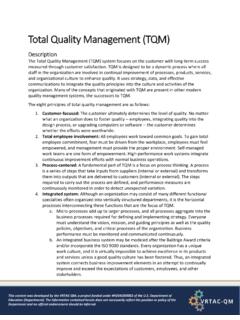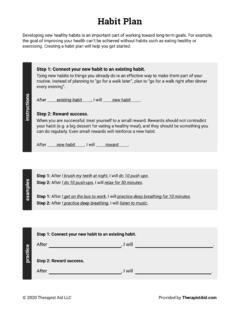Transcription of Kouzes and Posner: The Leadership Challenge
1 This content was developed by the VRTAC-QM, a project funded under #H264J200002 of the Department of Education (Department). The information contained herein does not necessarily reflect the position or policy of the Department and no official endorsement should be inferred. Kouzes and Posner: The Leadership Challenge Description Kouzes and Posner's The Leadership Challenge focuses on individual Leadership skills. Leadership is addressed with the identification of five Practices of Exemplary Leadership : 1. Model the way 2. Inspire a shared vision 3. Challenge the process 4. Enable others to act 5.
2 Encourage the heart At the core of this model is the principle that Leadership is everyone's business, and Leadership is measurable and learnable. They theorize that of people show Leadership ability and would say that virtually everyone can learn to be a leader. In their research, only people show absolutely no Leadership capability (1 out of 1 million people have no Leadership capability). So, the question is how to help the 99+% develop their Leadership skills. They created the Leadership Practices inventory (LPI), a behavioral assessment of the individual against the 5 Practices of Exemplary Leadership .
3 Regardless of your style, more frequent engagement in learning about Leadership leads to better practices of good Leadership . This model is about assessing leaders against the LPI and helping them grow and learn how to enact the behaviors associated with the 5 practices. Background Founders: Jim Kouzes , Executive Fellow for the Center for Innovation and Entrepreneurship, Leavey School of Business at Santa Clara University in California, and a Fellow at the Doerr Institute for New Leaders at Rice University. Barry Posner serves as the Michael Accolti Chair and Professor of Leadership for the Leavey School of Business at Santa Clara University, where he was Dean for 12 years.
4 Earned a Master's in Public Administrations and in Organizational Behavior and Administrative Theory at the University of Massachusetts Amherst. In the early 1980s, Kouzes and Posner began studying Leadership . They examined research in existence about Leadership and management. Next, they began a systematic process to research Leadership behaviors through survey and case study research. They looked to find individuals who were functioning at their Personal Best as a leader. Part of their research included studying managers and non-managers and their behaviors. Using their Personal Best Leadership Experience questionnaire (38 open-ended questions), they studied Leadership behaviors and trends of over 5000 respondents to the survey.
5 This content was developed by the VRTAC-QM, a project funded under #H264J200002 of the Department of Education (Department). The information contained herein does not necessarily reflect the position or policy of the Department and no official endorsement should be inferred. Sample questions included the following: Who initiated the project? What made you believe you could accomplish the results you sought? What, if any, special techniques or strategies did you use to get other people involved in the project? Did you do anything to mark the completion of the project at the end or along the way?
6 What did you learn most from this experience? What key lessons would you share with another person about Leadership from this experience? The basic tenet is that everyone can learn to be a leader. It is not intelligence/talent alone that gets results; it's continuous practice and efforts that achieve results. The best leaders have credibility on their side (honesty, forward-thinking, competence, and capacity to inspire). "You cannot command commitment; you must inspire it." DWYSYWD: Do what you say you will do! The five practices: Model the way Inspire a shared vision Challenge the process Enable others to act Encourage the heart Key themes: Be dependable and foster trust.
7 Embody virtues you want your team to embody. Develop your team culture and vision. Stack wins/successes and celebrate them. Love what you do, love life, and love the people you serve. The Leadership Practices Inventory Assessment (LPI): Kouzes and Posner went on to create the Leadership Practices Inventory (LPI) Assessment. They identified six behaviors for each of the five practices outlined above, for a total of 30 behaviors. These 30 behaviors were developed into the LPI assessment tool. It has strong validity and reliability. This assessment is inclusive of a self-assessment process as well as a 360 assessment; the 360 assessment is completed by team members that know the leader in the workplace and who are willing to provide their feedback concerning that person in relationship to the 30 practices.
8 The LPI components are outlined below: Self-Assessment: Completed by the individual This content was developed by the VRTAC-QM, a project funded under #H264J200002 of the Department of Education (Department). The information contained herein does not necessarily reflect the position or policy of the Department and no official endorsement should be inferred. LPI 360: Completed by 5-10 other people familiar with the person (manager, co-worker or peer, direct reports, or others familiar with the work behaviors/habits of the person) Completed forms go to an independent facilitator, who scores them by computer or hand.
9 There are additional services offered through an LPI 360+ process, which can include additional reports, modules, and other resource materials. Four types of reports are possible from the LPI: Individualized feedback on LPI 360 feedback from others with a breakdown of most/least frequent behaviors LPI Self-Report: A summary of the person's self-assessment on the 30 behaviors Reassessment Report: Used as a second assessment to report on an LPI 360+; longer process with pre-/post-testing over an 18-month period of time (lets people assess how they have changed over time) Group Assessment Report: If a team of people in a business work together, it is possible to have the team go through the process and have a post-assessment report.
10 People who complete the LPI assessment have access to Development Planner Vision Book Practice Book LPI Handouts The 360+ includes added modules to Challenge the leader in addition to numerous handouts to help them through the Leadership Challenge . The tool has been used for three decades. Kouzes and Posner have continued to study and update it during that time. They have developed further training options for coaches and facilitators of the training and the LPI assessment. There have not been any major changes to the model. Purpose Kouzes And Posner created the Leadership Challenge to help leaders develop their own Leadership skills and help organizations to create a learning environment to create leaders.







